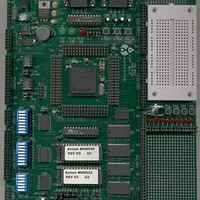MPC555CME Freescale Semiconductor, MPC555CME Datasheet - Page 501

MPC555CME
Manufacturer Part Number
MPC555CME
Description
KIT EVALUATION FOR MPC555
Manufacturer
Freescale Semiconductor
Type
Microcontrollerr
Datasheet
1.MPC555CME.pdf
(966 pages)
Specifications of MPC555CME
Contents
Module Board, Installation Guide, Power Supply, Cable, Software and more
Processor To Be Evaluated
MPC555
Data Bus Width
32 bit
Interface Type
RS-232
For Use With/related Products
MPC555
Lead Free Status / RoHS Status
Contains lead / RoHS non-compliant
- Current page: 501 of 966
- Download datasheet (13Mb)
14.7.6.1 Description of Slave Operation
MPC555
USER’S MANUAL
After reset, the QSMCM registers and the QSPI control registers must be initialized as
described above. Although the command control segment is not used, the transmit
and receive data segments may, depending upon the application, need to be initial-
ized. If meaningful data is to be sent out from the QSPI, the user should write the data
to the transmit data segment before enabling the QSPI.
If SPE is set and MSTR is not set, a low state on the slave select (PCS[0]/SS) pin com-
mences slave mode operation at the address indicated by NEWQP. The QSPI trans-
mits the data found in the transmit data segment at the address indicated by NEWQP,
and the QSPI stores received data in the receive data segment at the ad-dress indi-
cated by NEWQP. Data is transferred in response to an external slave clock input at
the SCK pin.
Because the command control segment is not used, the command control bits and pe-
ripheral chip-select codes have no effect in slave mode operation. The QSPI does not
drive any of the four peripheral chip-selects as outputs. PCS[0]/SS is used as an input.
Although CONT cannot be used in slave mode, a provision is made to enable receipt
of more than 16 data bits. While keeping the QSPI selected (PCS[0]/SS is held low),
the QSPI stores the number of bits, designated by BITS, in the current receive data
segment address, increments NEWQP, and continues storing the remaining bits (up
to the BITS value) in the next receive data segment address.
As long as PCS[0]/SS remains low, the QSPI continues to store the incoming bit
stream in sequential receive data segment addresses, until either the value in BITS is
reached or the end-of-queue address is used with wraparound mode disabled.
When the end of the queue is reached, the SPIF flag is asserted, optionally causing
an interrupt. If wraparound mode is disabled, any additional incoming bits are ignored.
If wraparound mode is enabled, storing continues at either address 0x0 or the address
of NEWQP, depending on the WRTO value. When using this capability to receive a
long incoming data stream, the proper delay between transfers must be used. The
QSPI requires time, approximately 0.425 µs with a 40-MHz IMB clock, to prefetch the
next transmit RAM entry for the next transfer. Therefore, the user may select a baud
rate that provides at least a 0.6-µs delay between successive transfers to ensure no
loss of incoming data. If the IMB clock is operating at a slower rate, the delay between
transfers must be increased proportionately.
Because the BITSE option in the command control segment is no longer available,
BITS sets the number of bits to be transferred for all transfers in the queue until the
CPU changes the BITS value. As mentioned above, until PCS[0]/SS is negated
(brought high), the QSPI continues to shift one bit for each pulse of SCK. If PCS[0]/SS
is negated before the proper number of bits (according to BITS) is received, the next
time the QSPI is selected it resumes storing bits in the same receive-data segment ad-
dress where it left off. If more than 16 bits are transferred before negating the PCS[0]/
SS, the QSPI stores the number of bits indicated by BITS in the current receive data
segment address, then increments the address and continues storing as described
/
MPC556
QUEUED SERIAL MULTI-CHANNEL MODULE
Rev. 15 October 2000
MOTOROLA
14-39
Related parts for MPC555CME
Image
Part Number
Description
Manufacturer
Datasheet
Request
R

Part Number:
Description:
MPC555 Interrupts
Manufacturer:
Freescale Semiconductor / Motorola
Datasheet:
Part Number:
Description:
Manufacturer:
Freescale Semiconductor, Inc
Datasheet:
Part Number:
Description:
Manufacturer:
Freescale Semiconductor, Inc
Datasheet:
Part Number:
Description:
Manufacturer:
Freescale Semiconductor, Inc
Datasheet:
Part Number:
Description:
Manufacturer:
Freescale Semiconductor, Inc
Datasheet:
Part Number:
Description:
Manufacturer:
Freescale Semiconductor, Inc
Datasheet:
Part Number:
Description:
Manufacturer:
Freescale Semiconductor, Inc
Datasheet:
Part Number:
Description:
Manufacturer:
Freescale Semiconductor, Inc
Datasheet:
Part Number:
Description:
Manufacturer:
Freescale Semiconductor, Inc
Datasheet:
Part Number:
Description:
Manufacturer:
Freescale Semiconductor, Inc
Datasheet:
Part Number:
Description:
Manufacturer:
Freescale Semiconductor, Inc
Datasheet:
Part Number:
Description:
Manufacturer:
Freescale Semiconductor, Inc
Datasheet:
Part Number:
Description:
Manufacturer:
Freescale Semiconductor, Inc
Datasheet:
Part Number:
Description:
Manufacturer:
Freescale Semiconductor, Inc
Datasheet:
Part Number:
Description:
Manufacturer:
Freescale Semiconductor, Inc
Datasheet:










